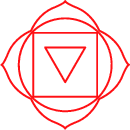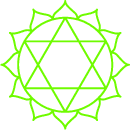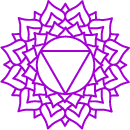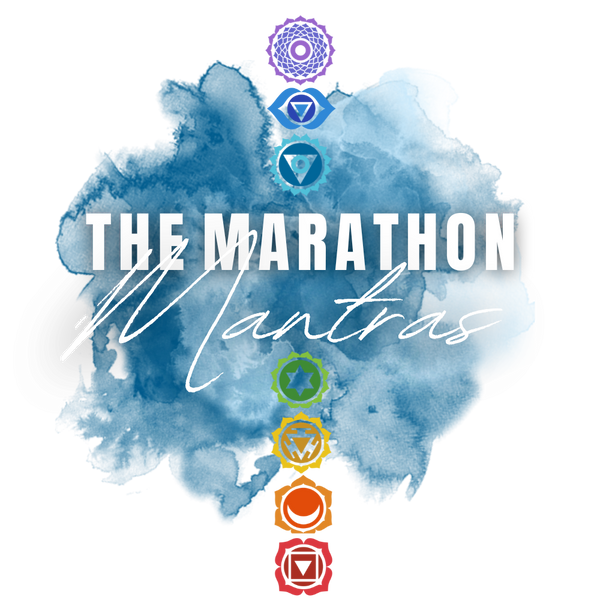About the 7 Chakras
Learn about the chakras, their symbols, attributes, benefits, effects and relation to yoga. Watch the video at the end and learn how to stimulate and balance these energy centers with their specific mantra (sound) and yantra (sign).
What are Chakras?
Chakras are the energy centers of the body. They are located in the astral body, along the spine, starting at its base and running upwards to the crown of the head. The astral body is the energy body residing inside our physical body. Each physical body part has a corresponding astral body part. The astral body cannot be seen or touched. This is also a reason why we cannot see the chakras.
The chakras radiate a specific colour and energy. Each one coincides with a gland in the physical body. Since each chakra relates to specific spiritual, emotional, psychological, and physical aspects of our being, it is believed that their blockage or malfunction can lead to physical, psychological, and emotional disorders. The conscious awareness and balancing of these energy centers, on the other hand, is believed to lead to well-being and good health.
The above ties into the purpose of yoga. Through asana practice, yoga seeks to stimulate and balance these chakras or energy centers in the body. Read on to learn more about the 7 chakras, their symbols, attributes, effects, and balancing techniques.
How many Chakras are there in the body?
Mostly, we hear about the ‘seven chakras’ but, there is an infinite number of chakras in the human body. A specific vibration, color, symbol and sound are associated with all 7 chakras. Depending on whether these energy centers are healthy or blocked, you may experience different attributes of your physical, mental, and emotional health. The 7 main chakras as they appear in the body are:
- Muladhara Chakra – Root Chakra
- Svadhishthana Chakra – Sacral Chakra
- Manipura Chakra – Solar Plexus Chakra
- Anahata Chakra – Heart Chakra
- Vishuddha Chakra – Throat Chakra
- Ajna Chakra – Third Eye Chakra
- Sahastrara Chakra – Crown Chakra
The 7 Chakras: Symbols, Symptoms and Effects
1. Muladhara Chakra – Root Chakra

Symbol: The Root Chakra symbol consists of a 4-petalled lotus flower, a square, and a downward-facing triangle. Each element is said to represent the 4 aspects of the human mind, uniting to form the birth of the human consciousness.
Color: Red
Element: Earth
Location: The Root Chakra also known as the Muladhara Chakra is located at the base of the spine, between the anus and the genitals. It is characterized by the emotions of survival, stability, ambition, and self-sufficiency.
Symptoms of a blocked Root Chakra: When this chakra is out of balance, a person starts feeling unstable, ungrounded, lack of ambition, lack of purpose, fearful, insecure and frustrated.
Signs of a balanced/imbalanced Root Chakra: However, when the Root Chakra is balanced, these are replaced by more positive emotions, and you feel stable, confident, balanced, energetic, independent, and strong.
Mantra: The seed mantra (beej mantra) of Muladhara Chakra is ‘Lam’.
Yoga poses to balance the Root Chakra:Tree Pose (Vrkshasana) and Mountain Pose (Tadasana).
2. Svadhishthana Chakra – Sacral Chakra

Symbol: The symbol for the Svadhishthana Chakra or Sacral Chakra is made up of multiple circles, a crescent moon, and six lotus flower petals. The circles and crescent moon represent the cyclical nature of life, death, and rebirth, while the 6 petals portray the 6 negative aspects of our nature that we need to overcome to open this chakra.
Color: Orange
Element: Water
Location: The Svadhishthana Chakra, more commonly known as the Sacral Chakra, is located in the lower abdomen, about four fingers below the navel. Its attributes include the basic need for sexuality, as well as creativity and self-worth.
Symptoms of a blocked/imbalanced Sacral Chakra: When the Sacral Chakra is imbalanced, a person may feel emotionally explosive and irritable, sense a lack of energy and creativity, feel manipulative, or obsessed with sexual thoughts.
Signs of a balanced Sacral Chakra: When balanced, it makes one feel more vibrant, happy, positive, satisfied, compassionate, and intuitive.
Mantra: The seed mantra (beej mantra) of Svadhishthana Chakra is ‘Vam’.
Yoga poses to activate the Sacral Chakra: You can work on balancing the Svadhishthana Chakra by practicing poses like Crow Pose (Kakasana) or standing poses like Triangle Pose (Trikonasana).
3. Manipura Chakra – Solar Plexus Chakra

Symbol: The Solar Plexus Chakra symbol consists of a downward-pointing triangle within a ten-petalled lotus flower. The ten petals symbolize ten negative character traits that we have to conquer, while the triangle is the Agni tattva or fire of kundalini energy which signifies our inner strength.
Color: Yellow
Element: Fire
Location: The Manipura Chakra is located at the solar plexus, between the navel and the bottom of the rib cage. It is characterized by emotions like ego, anger, and aggression.
Symptoms of a blocked/imbalanced Solar Plexus Chakra: An imbalance of the Solar Plexus Chakra can manifest physically as digestive problems, liver problems, or diabetes. On an emotional level, one might struggle with depression, lack of self-esteem, anger, and perfectionism.
Signs of a balanced Solar Plexus Chakra: By balancing this chakra, we feel more energetic, confident, productive, and focused.
Mantra: The seed mantra (beej mantra) of Manipura Chakra is ‘Ram’.
Yoga poses for Solar Plexus Chakra alignment: Working on Manipura Chakra can be done in poses like Classical Forward Bend
4. Anahata Chakra – Heart Chakra

Symbol: In the Heart Chakra symbol, two triangles intersect to form a yantra which represents the balance of yin and yang, or upward and downward forces. Outside, there is a lotus flower with 12 petals symbolizing the twelve divine qualities associated with the heart.
Color: Green
Element: Air
Location: As the name implies, the Anahata Chakra is located in the heart region. This chakra is the seat of balance, and it is characterized by emotions of love, attachment, compassion, trust, and passion.
Symptoms of a blocked/imbalanced Heart Chakra: When the heart chakra is imbalanced, a person may deal with emotional issues like anger, lack of trust, anxiety, jealousy, fear, and moodiness.
Signs of a balanced Heart Chakra: By harmonizing this energy center, a person begins to feel more compassionate, caring, optimistic, friendly, and motivated.
Mantra: The seed mantra (beej mantra) of Anahata Chakra is ‘Yam’.
Yoga poses to balance the Heart Chakra: Heart Chakra can be balanced by practicing poses like Half Bridge Pose (Ardha Setubandhasana), and Fish Pose (Matsyasana).
5. Vishuddha Chakra – Throat Chakra

Symbol: The symbol of the Throat Chakra consists of a 16-petalled lotus flower surrounding an inverted triangle which holds a circle within. This represents spiritual growth and the purification of the body, mind, and spirit.
Color: Blue
Element: Space
Location: The Visuddha Chakra is located at the base of the throat, coinciding with the thyroid gland. It is associated with inspiration, healthy expression, faith, and the ability to communicate well.
Symptoms of a blocked/imbalanced Throat Chakra: A blockage in the throat chakra may be experienced as timidity, quietness, a feeling of weakness, or the inability to express our thoughts.
Signs of a balanced Throat Chakra: When this chakra is balanced, it enables creativity, positive self-expression, constructive communication, and a sense of satisfaction.
Mantra: The seed mantra (beej mantra) of Vishuddha Chakra is ‘Ham’.
Yoga poses for Throat Chakra balance: Throat Chakra is stimulated in poses like Shoulderstand (Sarvangasana) and Plough Pose (Halasana).
6. Ajna Chakra – Third Eye Chakra

Symbol: The Third Eye Chakra symbol consists of an inverted triangle resting in a circle between two lotus petals. The two petals and downward-facing pyramid both signify wisdom, emphasizing the Third Eye Chakra’s role in our journey to spiritual awareness.
Color: Indigo
Element: None
Location: The Ajna Chakra (pronounced as ‘Agya Chakra’) is located between the eyebrows. Also known as the Third Eye Chakra, it is often used as a focal point during asana practice to develop more concentration and awareness. It is said that meditating upon this chakra destroys the karma of past lives and brings liberation and intuitive knowledge. Its attributes are intelligence, intuition, insight, and self-knowledge.
Symptoms of a blocked/imbalanced Third Eye Chakra: When imbalanced, it may make you feel non-assertive and afraid of success, or on the contrary, it can make you more egotistical. An imbalance can manifest as physical problems like headaches, blurry vision, and eye strain.
Signs of a balanced Third Eye Chakra: When this chakra is active and balanced, a person feels more vibrant and confident, both spiritually and emotionally. In the absence of the fear of death, one becomes his own master and remains free of all attachment to material things.
Mantra: The seed mantra (beej mantra) of Ajna Chakra is ‘Om’.
Yoga poses to balance the Third Eye Chakra: Ajna Chakra is stimulated when practicing Headstand (Shirshasana).
7. Sahastrara Chakra – Crown Chakra

Symbol: The Crown Chakra symbol is depicted as a ring of a thousand lotus petals surrounding an inverted triangle. This symbolizes the rising of divine energy into the Crown Chakra, bringing spiritual liberation and enlightenment.
Color: Violet White
Element: None
Location: The Sahastrara or Crown Chakra is located at the crown of the head. The seventh chakra is the center of spirituality, enlightenment, and dynamic thought and energy. It allows for the inward flow of wisdom and brings the gift of cosmic consciousness.
Symptoms of a blocked/imbalanced Crown Chakra: When it gets imbalanced, one might suffer from a constant sense of frustration, melancholy and destructive feelings.
Signs of a balanced Crown Chakra: A balanced Crown Chakra promotes spiritual understanding, inner peace and a clear perspective on the world.
Mantra: The seed mantra (beej mantra) of Sahastrara Chakra is ‘Aum’.
Yoga poses to align the Crown Chakra: Balancing Sahasrara Chakra can be done by practicing Headstand (Shirshasana).
Can Chakras influence health?
Chakras are associated with the organs and glands of the particular region where they are located. As such, they have a strong bearing on our health, our mental state, and our relation with others. Based on various factors such as our lifestyle, environment and surroundings, past experiences, etc, the chakras can either be balanced or imbalanced. If a chakra is imbalanced, it goes into either a hypoactive or a hyperactive mode. A hypoactive or blocked chakra’s functioning is either insufficient or reduced. Likewise, a hyperactive chakra means there is too much energy flowing into that particular region, and as such, there is an imbalance in the overall flow of energy throughout the body.
How do I know if my Chakras are blocked?
Since chakras are interrelated, when one of them is imbalanced, it causes a disturbance in the functionality of the other chakras as well. This makes people feel disconnected, anxious, fearful, and it also manifests as health problems in one or more areas of the body.
To function at their best, your chakras need to be balanced. And for this, you need to know what the chakras actually do and what are some of the things you can do to take care of them.
How do Chakras work and why are they important?
The chakras act as distribution centers. They distribute the five pranas to their associated local regions. For example, the root chakra will distribute the ‘apana prana’ to the pelvic region and provide energy for the organs in this region. When a chakra is blocked or not functioning properly, this distribution pattern gets disturbed, and physical or psycho-emotional/energy issues arise.
How to balance your Chakras
Every chakra rotates at a specific frequency and speed. This frequency and speed can change due to various factors like diet, lifestyle, thought patterns, etc. An imbalance starts creating problems with the distribution of the pranas. Imagine what will happen if a 50 watt light bulb starts getting a 500 watt or 10-watt electricity supply! When we speak about balancing or awakening the chakras, we mean bringing them back to their regular speed.
There is no one single method to unblock your chakras, but rather several. The best way to unblock your chakras will be different for everyone, and it’s a matter of trial and error to find out which method works for you. Here are a few popular tools and techniques for chakra cleansing and balancing:
1. Diet
One of the main reasons for an imbalance in the chakras is an imbalance of the five elements in the body. A balanced diet helps to bring balance to the elements of the body.
2. Asanas
Asanas help to stimulate the chakras, and improve their functioning. They also clear the way for the chakras to heal themselves.
3. Breathing
Breathing helps to increase the flow of prana in the body, and removes the stale prana.
4. Meditation
Many practitioners perform meditation to unblock chakras. Chakra meditation calms the mind and helps the practitioner focus energy towards a problematic point in the chakra system.
5. Mudras
Chakra Mudras are hand gestures typically performed in yoga and meditation to focus energy where it’s needed most. To balance the chakras, we balance the element in the body by performing the corresponding mudra. To find out more about yoga breathing exercises and Pranayama read on: “What Is the Difference between Pranayama and Breathing Exercises?”
Final Thought
The 7 chakras are powerful points in the energy body that help you maintain a healthy physical and emotional balance in life. For this reason, it’s vital that you observe these energy centers regularly and take time out of your busy day to improve the flow of prana to each. On a deeper level, aligning your chakras can also help you tune into your true Self and unlock the divine power within.
June 13, 2019 - Ram Jain
https://www.arhantayoga.org/blog/7-chakras-introduction-energy-centers-effect/

